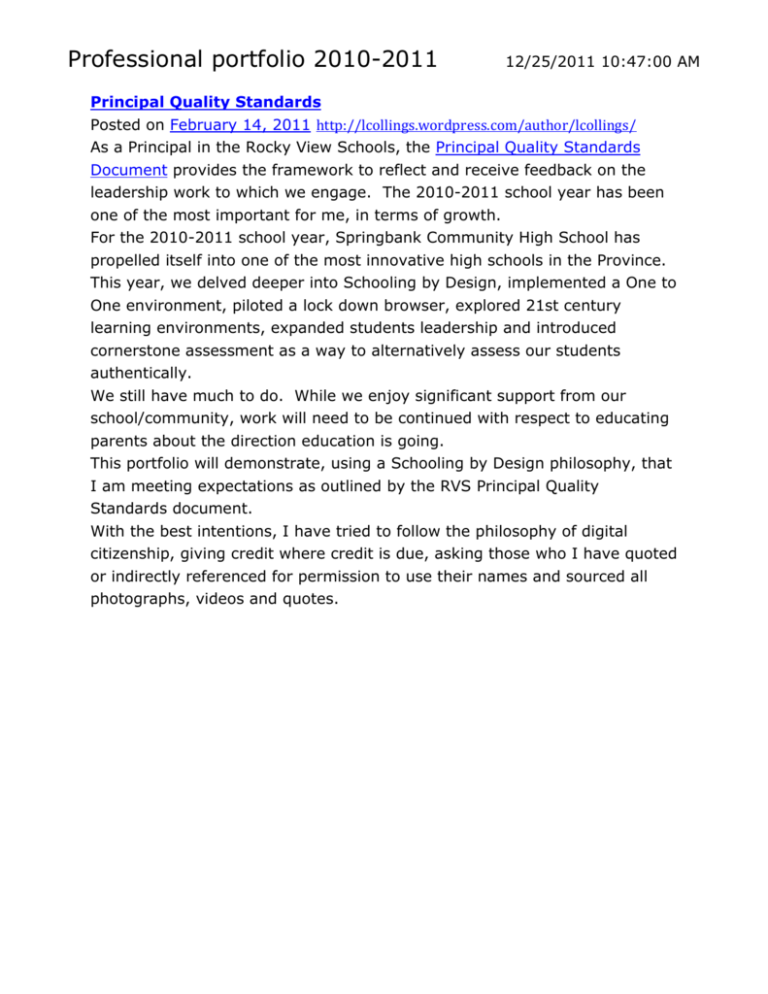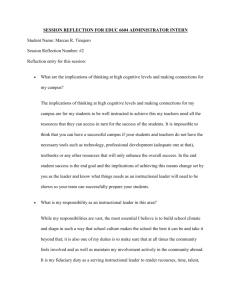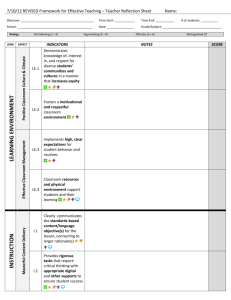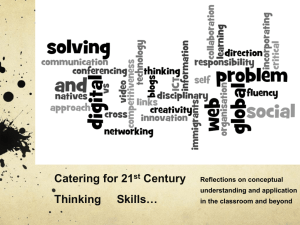Principal By Design - Journey 2010-2011
advertisement

Professional portfolio 2010-2011 12/25/2011 10:47:00 AM Principal Quality Standards Posted on February 14, 2011 http://lcollings.wordpress.com/author/lcollings/ As a Principal in the Rocky View Schools, the Principal Quality Standards Document provides the framework to reflect and receive feedback on the leadership work to which we engage. The 2010-2011 school year has been one of the most important for me, in terms of growth. For the 2010-2011 school year, Springbank Community High School has propelled itself into one of the most innovative high schools in the Province. This year, we delved deeper into Schooling by Design, implemented a One to One environment, piloted a lock down browser, explored 21st century learning environments, expanded students leadership and introduced cornerstone assessment as a way to alternatively assess our students authentically. We still have much to do. While we enjoy significant support from our school/community, work will need to be continued with respect to educating parents about the direction education is going. This portfolio will demonstrate, using a Schooling by Design philosophy, that I am meeting expectations as outlined by the RVS Principal Quality Standards document. With the best intentions, I have tried to follow the philosophy of digital citizenship, giving credit where credit is due, asking those who I have quoted or indirectly referenced for permission to use their names and sourced all photographs, videos and quotes. Developing and Fostering Leadership in Others12/25/2011 10:47:00 Developing and Fostering Leadership in Others Personal Reflection You cannot facilitate and foster leadership in schools alone. This link will hopefully illustrate some of the personal reflection I have done in this area. Developing and Fostering Leadership in Others Blog was originally created for the Administrator Leadership Development Program. I was a guest speaker at one of the sessions. 21st Century Learning Organizations When a school chooses a One to One environment, barriers to teaching and learning disappear and a new lens needs to be applied to the reality you find yourself in. It seems like a natural progression to begin to have different conversations with respect to the 21st century learning environment. The paper I have attached below became the next logical step in the journey. A group of interested individuals came together to explore opportunities. It became clear that the one area we would focus on would be looking at flexibility of “time”. The group read literature, Skyped with High Tech High, worked with Dr. David Townsend, had various meetings with RVS to understand hot to proceed in the area of “flexible time”. The White Paper – 21st Century Learning Environments was chosen as our guiding document. Using a collaborative decision-making model, the school is bringing forth the following concepts for next year planning: Flexible time within an inflexible timetable (i.e. blended courses, j-blocks, re-defining what instructional time looks like, hybrid concepts), advisory, electronic student portfolios, flexibility of space (learning commons and flex space for 21st century learners). The Backwards design with respect to next year’s course offerings is available to look at Flexible Opportunities. Edit Fostering Effective Relationships 12/25/2011 10:47:00 AM Fostering Effective Relationships Seek to understand, then to be understood. (Stephen Covey) Personal Reflection A universal truth about people is that they want to be heard. They want to be listened to. They want to be part of decision-making. These things take time to build and foster. Below are some examples of how I illustrate that process. Academic Leaders At Springbank Community High School, we believe that the role of the Curriculum Leader needs to change into the role of the Academic Leader. For the past two years, we are changing the way Curriculum Leaders view their role. This has been an effective way of taking the academic relationship to a new level. When there exists a clear role, then effective and positive work flows. The following will illustrate the change: Role of the Academic Leader (Schooling by Design, Wiggins and McTighe) Responsibilities Related to Mission and Learning Principles Responsibilities Related Responsibilities Related Professional Learning Responsibilities Related Time & Mission Responsibilities Related Individual Meetings to Curriculum to Results to Structure, Policies and Resources to Culture In January, we had a change in leadership. It was clear to me that I needed to go back to something I did when I first began at the school which was to have individual meetings with all staff. I began with sending the Teaching Preferences Inventory Form to each staff member. They were invited to a Google Calendar to book their appointments. I gave them a deadline. The inventory form was the focus of the first part of the meeting. The following were the essential questions we used as our discussion. The theme is our Mission statement items on creative and critical thinking and media literacy. Essential Questions (Teachers) If you have finished Moodle, what were your strategies to complete? If you have not, what is your plan to complete Moodle? What have you done to integrate technology into your practice What have you done to integrate UBD into your practice? If the opportunity presents itself would you be willing to offer a blended course in the future? Do you still see this as a place for you considering the changes that have occurred? Where do you see yourself with respect to your practice in 5 years? What do you need now to assist you in making the transition to a 21st century teacher? Academic leaders had slightly different questions as their roles are different. Essential Questions (Academic Leaders) If leading by example is an important component of leadership, how have you led by example? Are you actively on board with the direction our practice is moving? What are the perceptions of the people in your department with respect to the changes currently underway? What is your department measure of success? Do you see yourself as the person to move your department forward? (Chinese Symbol, “To Listen”, from Google Images) Leading a Learning Community 12/25/2011 10:47:00 AM Leading a Learning Community Reflection: Perhaps one of the most inspiring quotes for me comes from Dr. Sharon Friesen from the University of Calgary. In the document, entitled, http://lcollings.files.wordpress.com/2011/02/wdydist_national_report_en.pdfWhat Did You Do In School Today? National Report, She writes: Effective teaching begins with the thoughtful and intentional design of learning that engages students intellectually and academically. Students are asked to undertake work that is worthy of their time and attention, is personally relevant, and deeply connected to the world in which they live. Assessment practices are clearly focused on improving student learning and guiding teaching decisions and actions. Teachers foster a variety of interdependent relationships in classrooms that promote learning and create a strong culture around learning. Teachers improve their practice in the company of peers. Surrounding and infused into each of these core principles is the effective use of the technologies. It is undeniable that the face of education and the role of technology are changing rapidly. When we first delved into 21st Century Learning Environments, we were thinking very superficially. As we backwards designed the process, it became very clear we needed to hear the teacher, student and the parent voice. We invited them into a process to design with us what a 21st century learning environment would look like. Below is the process we had our stakeholders engaged in. Reading the Literature Staff, Parents, and students were invited to read the White Paper – 21st Century Learning Environments. From there, one of our staff, Dr. Heather Fansher developed a one page document, “at a glance” that is available to read here Imagining the Future. The feedback from the document, entitled Pillars – Conversation with staff, parents, and students was both informative and important to listen to. Perhaps the most exciting part of the voices captured during this process was that it reaffirms we are on the right track. Cornerstone Assessment Stumbling blocks are one of our biggest challenges. The question I often ask myself is, what is stopping us? When we first began the process of transforming SCHS into a 21st century learning environment, there were road blocks. Although staff could somewhat articulate the main challenge, we were having difficulty seeing it clearly. Through a process that is called, “Group Thinking“, we were able to get to the nub of what was stopping us from reaching our next level. The key road block was that we, value product over process. This is, I believe not an uncommon challenge. But, what this process did was open it up for us to take a look at. This is where the concept of Authentic and Cornerstone Assessment came into play. It gave us the opportunity to begin thinking about assessment in a different way. And, the 3-Year Plan gave us the opportunity to make it a goal for improvement. Since then, there have been major advances in the thought process of both the teachers and parents. I am now hearing things from parents like, “that exam does not assess how students are learning”. THAT is progress. Managing Effectively 12/25/2011 10:47:00 AM Managing Effectively Reflection: I had the privilege of working with Dorothy Dyer for five years as her Assistant Principal. Among the many things I learned from Dorothy was the idea that to facilitate leadership and create a stable school environment, the role of the Principal is not a power and control endeavour. Further, “enabling” processes are imperative. Schooling by Design is processoriented. It clearly lays out responsibilities and roles. An example of facilitating leadership in others comes from the Chapter 1, “Mission” and chapter 7 entitled, “The Role of Academic Leader”. Springbank Community High School creates processes through backwards design. Schooling By Design is illustrated nicely in this document. Mission is also important. When I first came to this school, there was incredible amount of discussion related to international travel and the incoherence with the programs. The policy below illustrates how powerful processes and policies are in running schools. The development of this process has assisted in giving shape to travel as well as placing parameters over it. Every March, the committee meets to: review the process and to hear the travel proposed for the next year. Field trip procedures are contained in this link. Check out the Letter to Teachers – Approval form. Teachers use a standard form for information to students in the SCHS Travel Contract. Providing Instructional Leadership 12/25/2011 10:47:00 AM Providing Instructional Leadership “You must be the change you want to see in the world.” – Mahatma Gandhi Learning Walks Reflection: For several years, I have struggled with “how” to be an effective instructional leader. This is the most important leadership dimension and probably the most poorly understood and haphazardly done. As part of my Professional Growth Plan, it has been my desire to do a better job in this area, however it has been an illusive goal. I simply didn’t know how to get better. Through my mentor, Dr. Guilott, I was introduced to Learning Walks and I feel I have found the “how”. Here is the handout she provided: Learning Walks Learning Walks are, perhaps, the most powerful tool to providing quality instructional leadership. It has profoundly changed my practice as an instructional leader. I have introduced this to 4 other administrators in this Division, thus creating capacity in this jurisdiction. “I am learning how to be a better instructional leader. You can help me to achieve this goal.” This is a phrase I used with my first year teachers. In addition to struggling with how to be a better instructional leader, I feel we need to do a better job with our beginning teachers. I am working on a process to mentor beginning teachers. Outlined below is the process I am working on: Pre-conference – I outlined my expectation to the teacher during a one to one conference. I reiterated that fact that I am learning as well. The model chosen closely aligns with the Divisional model; balanced assessment, understanding by design, universal design for learning. No evaluation would take place until they had practiced and honed in on their skills. I started out with Marzano’s Observational Protocols MarzanosObservationalProtocol. Beginning teachers reviewed this document and then we met and set goals. What did they want to work on? After approximately 6 weeks, we had another conference. Are you ready for a learning walk? Learning walk occurred. Teachers on the learning walk reflected on their own practice. I gave feedback to the beginning teachers which included observations on their goals Learning Walk participation offered. After the initial learning walk, beginning teachers were given an opportunity to be a participant on the learning walk based on their specific goals. Evaluation observations were booked for semester 1. Beginning teachers were given the opportunity to choose the classes I was to view based on observables from their goals. Evaluation #1 was completed, vetted with the beginning teachers and submitted to the Division. Using an outside facilitator, two meetings were organized to bring together all of the beginning teachers. Using the activity linked here Make Meaning Leading to Transfer, beginning teachers discussed how to improve their practice. Click here to view their feedback Feedback from Make Meaning Leading to Transfer. Tansfer Tips handout is helpful to give to teachers Transfer10tips (All links above have been created by Dr. Margo Guilott “Authentic Education” and are used with her permission.) Providing Visionary Leadership 12/25/2011 10:47:00 AM Providing Visionary Leadership Reflection: The number one benefit of information technology is that it empowers people to do what they want to do. It lets people be creative. It lets people be productive. It lets people learn things they didn’t think they could learn before, and it removes THE barrier. This tool has contributed to huge transformational move in this school. Coupled with a sound philosophy, a focus on change, this has propelled this school to a different level of thinking about what the future of education looks like. I must caution anyone reading this that moving to a one to one environment alone will not transform teaching and learning. In tandem, you must have philosophy in place, a critical mass with a baseline of skills to take on the challenge, and the ability to know when to “turn up the heat”, “keep the heat simmer”, and “when to turn the heat off”. Take a look at the video produced at SCHS that talks about the One to One project. The SCHS One to One video was created by Rick Gaudio and used with his permission. Societal Context 12/25/2011 10:47:00 AM Societal Context Refelction: Since becoming a One to One school, we have been working with other schools in the jurisdiction to assist them in their desire to implement this kind of initiative in their own schools. For example, we have been working specifically with both high schools in Cochrane to assist with their process in moving to a one to one environment. Through bi-weekly Skypes and personal contact, the schools have shared their learnings, and is providing mentorship to these schools. Our School/Community were surveyed as to their perspectives on twentyfirst century environments. Two things came from this survey; the first is that parents are eager to learn about what their students are doing at school with respect to learning and technology. We responded by setting up a Parent Professional Learning opportunity aimed at two things: Firstly, a look at how the Springbank Community High School Website is leveraged for information and learning. Secondly, Mahara Portfolio System and how it relates to the four-year plan and student individual learning plans. Lastly, the Moodle Learning Management System and how it leverages learning any time anywhere, and any place. Parents are still very reticent about the web and very much focus on the negative. However, with a lot of talk, a great amount of information through the newsletters and professional learning, things are slowly changing. One of the most important learning we have had is in the area of Digital Citizenship and the crucial piece it plays in a One to One environment. Dr. Amy Burns and myself created a Community of Practice, called Digital Citizenship. Inspired by Carmen Christie-Bill’s presentation at the Emerge 2010 Summit, we realized the power of the information. It is not meant to be a set of “rights and wrongs”, but rather information presented in a thought-provoking discussion oriented way. Carmen’s Website is included here as a great resource. Carmen’s material is all open sourced and she gave us a great deal of information. Particularly, she skilled us in the area of open source material and what that means. Creative Commons and other open sources, such as Google images are great places to get images with full/partial/limited permission. This encourages users to use information without having the concern of what is copyright and what isn’t. In November, I presented Digital Citizenship to a symposium at the University of Calgary. You can view it here Digital Citizenship U of C presentation Final copy. There is not question that the power of the student voice is so very important in schools. Having students on board and working with you on innovation is crucial to the success of the endeavor. To this end, we had a leadership student take on the monumental task of presenting Digital Citizenship to students, parents and the larger community during the month of January, 2011. With her permission, I have included the presentation and it can be viewed here Student-led Digital Citizenship Presentation. Since these presentations, she has been asked to present at other schools. She will be traveling to Chestermere to do a presentation to Rainbow Creek students in April, 2011. I believe that what we are doing here and what others are creating elsewhere needs to be shared. At the High Schools level, we are creating the conditions to work together more collaboratively. A sample of the visioning information is outlined here long term vision for high schools. I was approached contribute to a RVS Blog. The SCHS administration team decided to work on this collaboratively. To this end, we submitted our first contribution, entitled, “Binders Optional”. When a school goes to a one to one environment, you can see very quickly that the game changes. There are many things that change, some for the better, some to challenge your thinking. However, all necessary things for us to experience as we begin to see how technology is a game changer. The second submission, entitled, “It Is About the Learning, Not the Gadgets, is about the profound learning experiences that happen at High Tech High, a prototypes for Springbank Community High’s transformation. (Chinese symbol of “journey” taken from Google images)




